Leading and Managing Change: A Report on Sainsbury's Strategies
VerifiedAdded on 2023/01/11
|11
|3820
|54
Report
AI Summary
This report examines the critical role of change management within Sainsbury's, focusing on the impact of external factors, particularly Brexit, on the company's operations and strategic direction. The report delves into the need for both planned and unplanned change approaches, highlighting the importance of the Human Resource (HR) department in navigating these transitions. It analyzes the challenges faced by Sainsbury's, including operational and strategic changes, and evaluates the support provided by the HR department. The report utilizes PESTLE analysis to assess the macro-environmental factors influencing Sainsbury's, and applies the Ansoff Matrix to evaluate growth strategies. Furthermore, the report explores the challenges for the HR department and strategic approaches to deal with such challenges. The report provides a comprehensive overview of how Sainsbury's can effectively manage change to maintain market leadership and adapt to evolving market conditions.
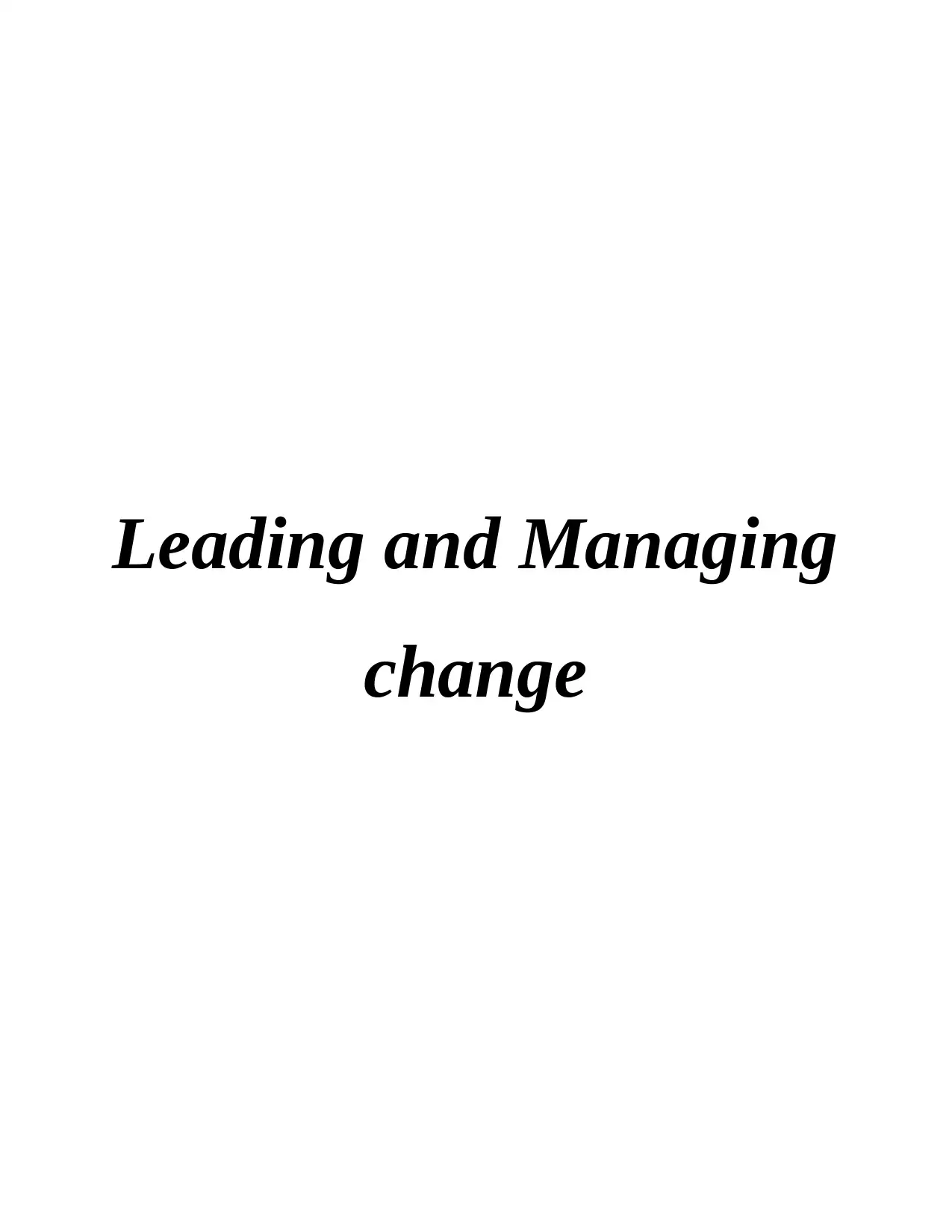
Leading and Managing
change
change
Paraphrase This Document
Need a fresh take? Get an instant paraphrase of this document with our AI Paraphraser
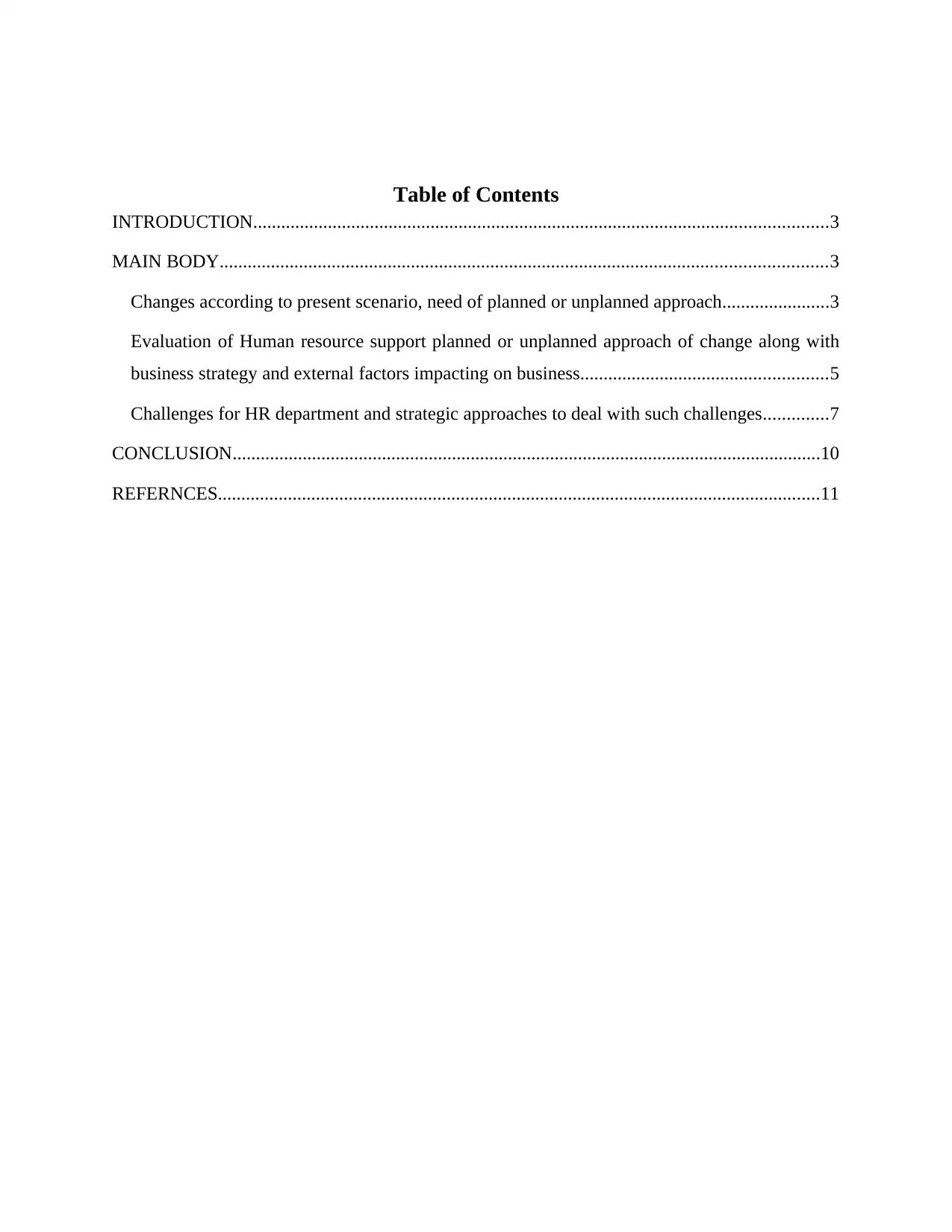
Table of Contents
INTRODUCTION...........................................................................................................................3
MAIN BODY..................................................................................................................................3
Changes according to present scenario, need of planned or unplanned approach.......................3
Evaluation of Human resource support planned or unplanned approach of change along with
business strategy and external factors impacting on business.....................................................5
Challenges for HR department and strategic approaches to deal with such challenges..............7
CONCLUSION..............................................................................................................................10
REFERNCES.................................................................................................................................11
INTRODUCTION...........................................................................................................................3
MAIN BODY..................................................................................................................................3
Changes according to present scenario, need of planned or unplanned approach.......................3
Evaluation of Human resource support planned or unplanned approach of change along with
business strategy and external factors impacting on business.....................................................5
Challenges for HR department and strategic approaches to deal with such challenges..............7
CONCLUSION..............................................................................................................................10
REFERNCES.................................................................................................................................11
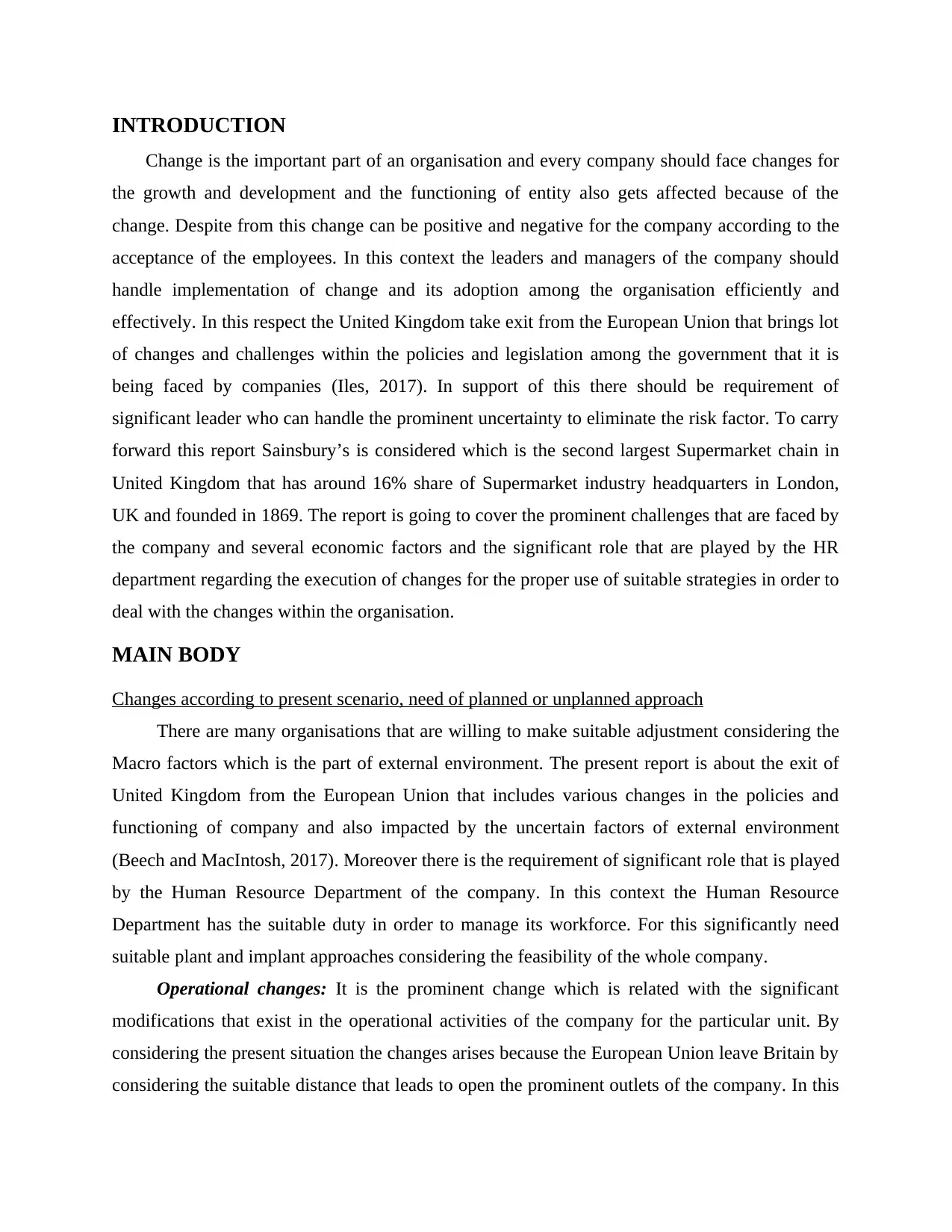
INTRODUCTION
Change is the important part of an organisation and every company should face changes for
the growth and development and the functioning of entity also gets affected because of the
change. Despite from this change can be positive and negative for the company according to the
acceptance of the employees. In this context the leaders and managers of the company should
handle implementation of change and its adoption among the organisation efficiently and
effectively. In this respect the United Kingdom take exit from the European Union that brings lot
of changes and challenges within the policies and legislation among the government that it is
being faced by companies (Iles, 2017). In support of this there should be requirement of
significant leader who can handle the prominent uncertainty to eliminate the risk factor. To carry
forward this report Sainsbury’s is considered which is the second largest Supermarket chain in
United Kingdom that has around 16% share of Supermarket industry headquarters in London,
UK and founded in 1869. The report is going to cover the prominent challenges that are faced by
the company and several economic factors and the significant role that are played by the HR
department regarding the execution of changes for the proper use of suitable strategies in order to
deal with the changes within the organisation.
MAIN BODY
Changes according to present scenario, need of planned or unplanned approach
There are many organisations that are willing to make suitable adjustment considering the
Macro factors which is the part of external environment. The present report is about the exit of
United Kingdom from the European Union that includes various changes in the policies and
functioning of company and also impacted by the uncertain factors of external environment
(Beech and MacIntosh, 2017). Moreover there is the requirement of significant role that is played
by the Human Resource Department of the company. In this context the Human Resource
Department has the suitable duty in order to manage its workforce. For this significantly need
suitable plant and implant approaches considering the feasibility of the whole company.
Operational changes: It is the prominent change which is related with the significant
modifications that exist in the operational activities of the company for the particular unit. By
considering the present situation the changes arises because the European Union leave Britain by
considering the suitable distance that leads to open the prominent outlets of the company. In this
Change is the important part of an organisation and every company should face changes for
the growth and development and the functioning of entity also gets affected because of the
change. Despite from this change can be positive and negative for the company according to the
acceptance of the employees. In this context the leaders and managers of the company should
handle implementation of change and its adoption among the organisation efficiently and
effectively. In this respect the United Kingdom take exit from the European Union that brings lot
of changes and challenges within the policies and legislation among the government that it is
being faced by companies (Iles, 2017). In support of this there should be requirement of
significant leader who can handle the prominent uncertainty to eliminate the risk factor. To carry
forward this report Sainsbury’s is considered which is the second largest Supermarket chain in
United Kingdom that has around 16% share of Supermarket industry headquarters in London,
UK and founded in 1869. The report is going to cover the prominent challenges that are faced by
the company and several economic factors and the significant role that are played by the HR
department regarding the execution of changes for the proper use of suitable strategies in order to
deal with the changes within the organisation.
MAIN BODY
Changes according to present scenario, need of planned or unplanned approach
There are many organisations that are willing to make suitable adjustment considering the
Macro factors which is the part of external environment. The present report is about the exit of
United Kingdom from the European Union that includes various changes in the policies and
functioning of company and also impacted by the uncertain factors of external environment
(Beech and MacIntosh, 2017). Moreover there is the requirement of significant role that is played
by the Human Resource Department of the company. In this context the Human Resource
Department has the suitable duty in order to manage its workforce. For this significantly need
suitable plant and implant approaches considering the feasibility of the whole company.
Operational changes: It is the prominent change which is related with the significant
modifications that exist in the operational activities of the company for the particular unit. By
considering the present situation the changes arises because the European Union leave Britain by
considering the suitable distance that leads to open the prominent outlets of the company. In this
⊘ This is a preview!⊘
Do you want full access?
Subscribe today to unlock all pages.

Trusted by 1+ million students worldwide
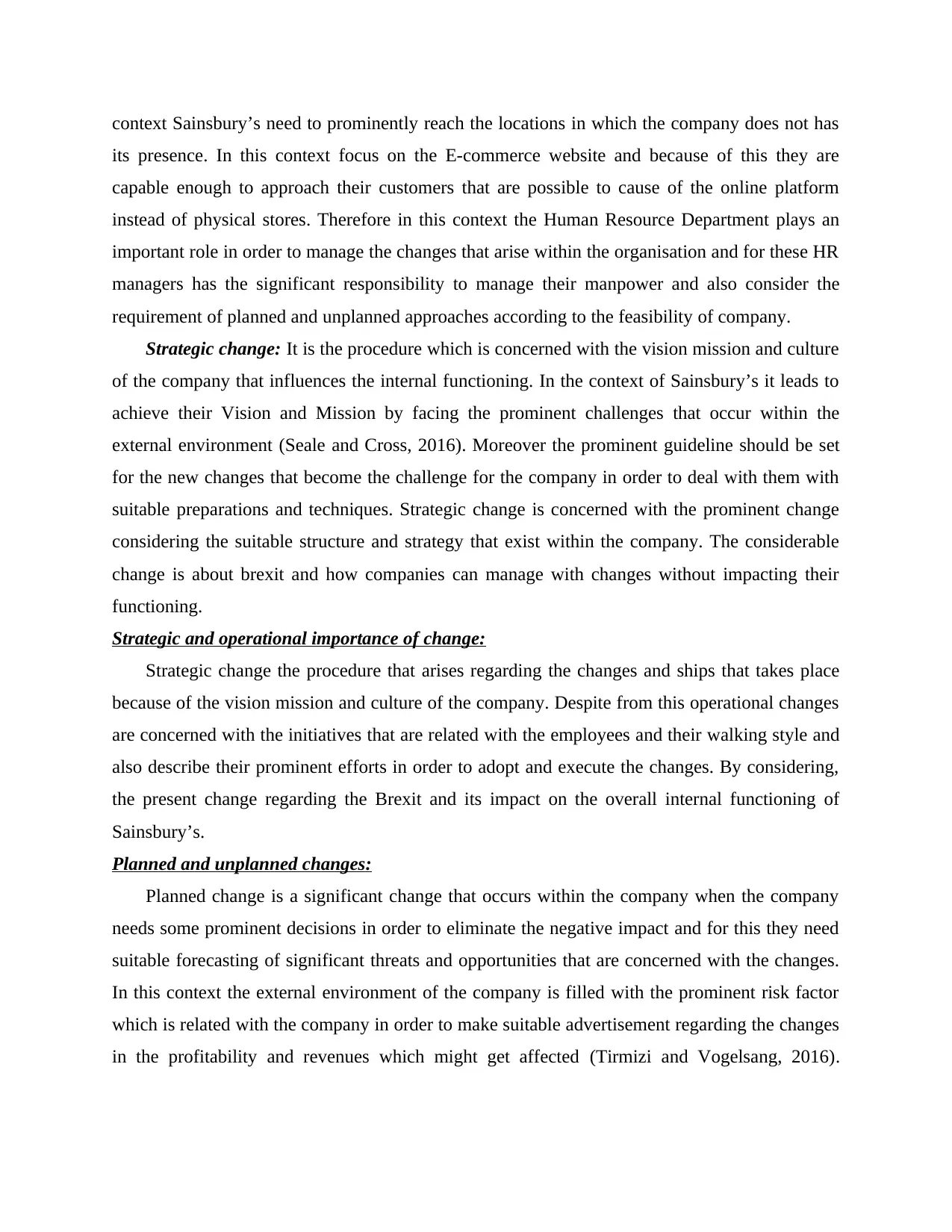
context Sainsbury’s need to prominently reach the locations in which the company does not has
its presence. In this context focus on the E-commerce website and because of this they are
capable enough to approach their customers that are possible to cause of the online platform
instead of physical stores. Therefore in this context the Human Resource Department plays an
important role in order to manage the changes that arise within the organisation and for these HR
managers has the significant responsibility to manage their manpower and also consider the
requirement of planned and unplanned approaches according to the feasibility of company.
Strategic change: It is the procedure which is concerned with the vision mission and culture
of the company that influences the internal functioning. In the context of Sainsbury’s it leads to
achieve their Vision and Mission by facing the prominent challenges that occur within the
external environment (Seale and Cross, 2016). Moreover the prominent guideline should be set
for the new changes that become the challenge for the company in order to deal with them with
suitable preparations and techniques. Strategic change is concerned with the prominent change
considering the suitable structure and strategy that exist within the company. The considerable
change is about brexit and how companies can manage with changes without impacting their
functioning.
Strategic and operational importance of change:
Strategic change the procedure that arises regarding the changes and ships that takes place
because of the vision mission and culture of the company. Despite from this operational changes
are concerned with the initiatives that are related with the employees and their walking style and
also describe their prominent efforts in order to adopt and execute the changes. By considering,
the present change regarding the Brexit and its impact on the overall internal functioning of
Sainsbury’s.
Planned and unplanned changes:
Planned change is a significant change that occurs within the company when the company
needs some prominent decisions in order to eliminate the negative impact and for this they need
suitable forecasting of significant threats and opportunities that are concerned with the changes.
In this context the external environment of the company is filled with the prominent risk factor
which is related with the company in order to make suitable advertisement regarding the changes
in the profitability and revenues which might get affected (Tirmizi and Vogelsang, 2016).
its presence. In this context focus on the E-commerce website and because of this they are
capable enough to approach their customers that are possible to cause of the online platform
instead of physical stores. Therefore in this context the Human Resource Department plays an
important role in order to manage the changes that arise within the organisation and for these HR
managers has the significant responsibility to manage their manpower and also consider the
requirement of planned and unplanned approaches according to the feasibility of company.
Strategic change: It is the procedure which is concerned with the vision mission and culture
of the company that influences the internal functioning. In the context of Sainsbury’s it leads to
achieve their Vision and Mission by facing the prominent challenges that occur within the
external environment (Seale and Cross, 2016). Moreover the prominent guideline should be set
for the new changes that become the challenge for the company in order to deal with them with
suitable preparations and techniques. Strategic change is concerned with the prominent change
considering the suitable structure and strategy that exist within the company. The considerable
change is about brexit and how companies can manage with changes without impacting their
functioning.
Strategic and operational importance of change:
Strategic change the procedure that arises regarding the changes and ships that takes place
because of the vision mission and culture of the company. Despite from this operational changes
are concerned with the initiatives that are related with the employees and their walking style and
also describe their prominent efforts in order to adopt and execute the changes. By considering,
the present change regarding the Brexit and its impact on the overall internal functioning of
Sainsbury’s.
Planned and unplanned changes:
Planned change is a significant change that occurs within the company when the company
needs some prominent decisions in order to eliminate the negative impact and for this they need
suitable forecasting of significant threats and opportunities that are concerned with the changes.
In this context the external environment of the company is filled with the prominent risk factor
which is related with the company in order to make suitable advertisement regarding the changes
in the profitability and revenues which might get affected (Tirmizi and Vogelsang, 2016).
Paraphrase This Document
Need a fresh take? Get an instant paraphrase of this document with our AI Paraphraser
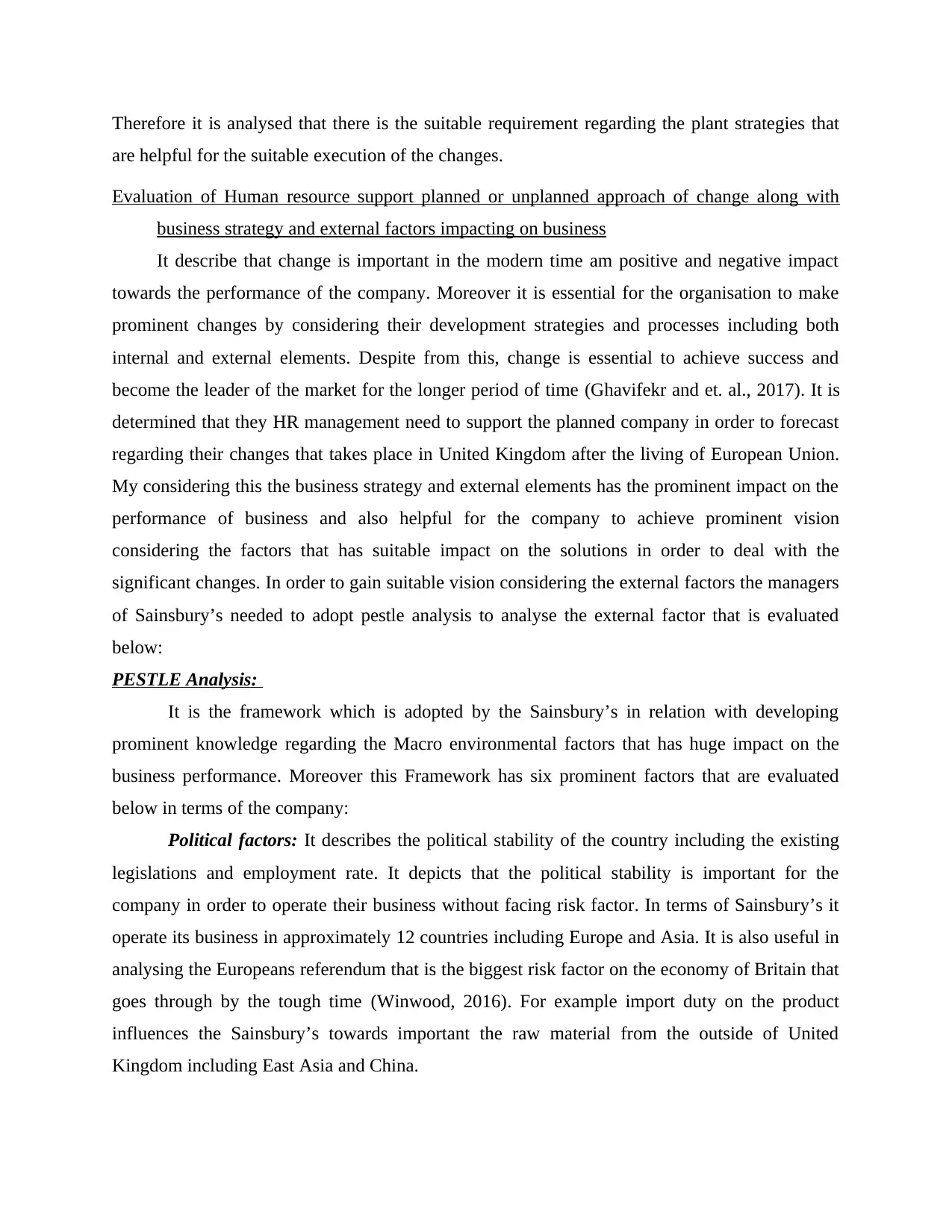
Therefore it is analysed that there is the suitable requirement regarding the plant strategies that
are helpful for the suitable execution of the changes.
Evaluation of Human resource support planned or unplanned approach of change along with
business strategy and external factors impacting on business
It describe that change is important in the modern time am positive and negative impact
towards the performance of the company. Moreover it is essential for the organisation to make
prominent changes by considering their development strategies and processes including both
internal and external elements. Despite from this, change is essential to achieve success and
become the leader of the market for the longer period of time (Ghavifekr and et. al., 2017). It is
determined that they HR management need to support the planned company in order to forecast
regarding their changes that takes place in United Kingdom after the living of European Union.
My considering this the business strategy and external elements has the prominent impact on the
performance of business and also helpful for the company to achieve prominent vision
considering the factors that has suitable impact on the solutions in order to deal with the
significant changes. In order to gain suitable vision considering the external factors the managers
of Sainsbury’s needed to adopt pestle analysis to analyse the external factor that is evaluated
below:
PESTLE Analysis:
It is the framework which is adopted by the Sainsbury’s in relation with developing
prominent knowledge regarding the Macro environmental factors that has huge impact on the
business performance. Moreover this Framework has six prominent factors that are evaluated
below in terms of the company:
Political factors: It describes the political stability of the country including the existing
legislations and employment rate. It depicts that the political stability is important for the
company in order to operate their business without facing risk factor. In terms of Sainsbury’s it
operate its business in approximately 12 countries including Europe and Asia. It is also useful in
analysing the Europeans referendum that is the biggest risk factor on the economy of Britain that
goes through by the tough time (Winwood, 2016). For example import duty on the product
influences the Sainsbury’s towards important the raw material from the outside of United
Kingdom including East Asia and China.
are helpful for the suitable execution of the changes.
Evaluation of Human resource support planned or unplanned approach of change along with
business strategy and external factors impacting on business
It describe that change is important in the modern time am positive and negative impact
towards the performance of the company. Moreover it is essential for the organisation to make
prominent changes by considering their development strategies and processes including both
internal and external elements. Despite from this, change is essential to achieve success and
become the leader of the market for the longer period of time (Ghavifekr and et. al., 2017). It is
determined that they HR management need to support the planned company in order to forecast
regarding their changes that takes place in United Kingdom after the living of European Union.
My considering this the business strategy and external elements has the prominent impact on the
performance of business and also helpful for the company to achieve prominent vision
considering the factors that has suitable impact on the solutions in order to deal with the
significant changes. In order to gain suitable vision considering the external factors the managers
of Sainsbury’s needed to adopt pestle analysis to analyse the external factor that is evaluated
below:
PESTLE Analysis:
It is the framework which is adopted by the Sainsbury’s in relation with developing
prominent knowledge regarding the Macro environmental factors that has huge impact on the
business performance. Moreover this Framework has six prominent factors that are evaluated
below in terms of the company:
Political factors: It describes the political stability of the country including the existing
legislations and employment rate. It depicts that the political stability is important for the
company in order to operate their business without facing risk factor. In terms of Sainsbury’s it
operate its business in approximately 12 countries including Europe and Asia. It is also useful in
analysing the Europeans referendum that is the biggest risk factor on the economy of Britain that
goes through by the tough time (Winwood, 2016). For example import duty on the product
influences the Sainsbury’s towards important the raw material from the outside of United
Kingdom including East Asia and China.
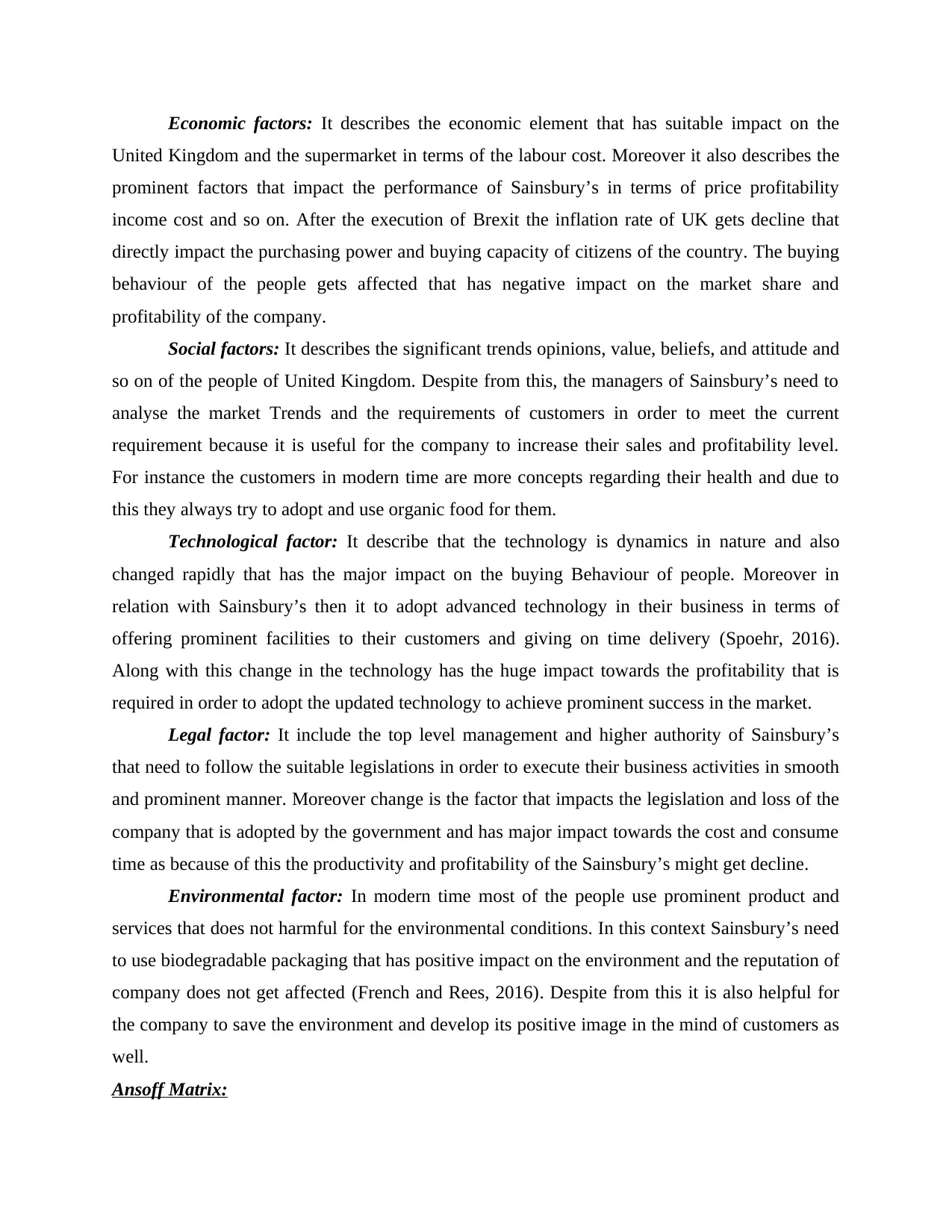
Economic factors: It describes the economic element that has suitable impact on the
United Kingdom and the supermarket in terms of the labour cost. Moreover it also describes the
prominent factors that impact the performance of Sainsbury’s in terms of price profitability
income cost and so on. After the execution of Brexit the inflation rate of UK gets decline that
directly impact the purchasing power and buying capacity of citizens of the country. The buying
behaviour of the people gets affected that has negative impact on the market share and
profitability of the company.
Social factors: It describes the significant trends opinions, value, beliefs, and attitude and
so on of the people of United Kingdom. Despite from this, the managers of Sainsbury’s need to
analyse the market Trends and the requirements of customers in order to meet the current
requirement because it is useful for the company to increase their sales and profitability level.
For instance the customers in modern time are more concepts regarding their health and due to
this they always try to adopt and use organic food for them.
Technological factor: It describe that the technology is dynamics in nature and also
changed rapidly that has the major impact on the buying Behaviour of people. Moreover in
relation with Sainsbury’s then it to adopt advanced technology in their business in terms of
offering prominent facilities to their customers and giving on time delivery (Spoehr, 2016).
Along with this change in the technology has the huge impact towards the profitability that is
required in order to adopt the updated technology to achieve prominent success in the market.
Legal factor: It include the top level management and higher authority of Sainsbury’s
that need to follow the suitable legislations in order to execute their business activities in smooth
and prominent manner. Moreover change is the factor that impacts the legislation and loss of the
company that is adopted by the government and has major impact towards the cost and consume
time as because of this the productivity and profitability of the Sainsbury’s might get decline.
Environmental factor: In modern time most of the people use prominent product and
services that does not harmful for the environmental conditions. In this context Sainsbury’s need
to use biodegradable packaging that has positive impact on the environment and the reputation of
company does not get affected (French and Rees, 2016). Despite from this it is also helpful for
the company to save the environment and develop its positive image in the mind of customers as
well.
Ansoff Matrix:
United Kingdom and the supermarket in terms of the labour cost. Moreover it also describes the
prominent factors that impact the performance of Sainsbury’s in terms of price profitability
income cost and so on. After the execution of Brexit the inflation rate of UK gets decline that
directly impact the purchasing power and buying capacity of citizens of the country. The buying
behaviour of the people gets affected that has negative impact on the market share and
profitability of the company.
Social factors: It describes the significant trends opinions, value, beliefs, and attitude and
so on of the people of United Kingdom. Despite from this, the managers of Sainsbury’s need to
analyse the market Trends and the requirements of customers in order to meet the current
requirement because it is useful for the company to increase their sales and profitability level.
For instance the customers in modern time are more concepts regarding their health and due to
this they always try to adopt and use organic food for them.
Technological factor: It describe that the technology is dynamics in nature and also
changed rapidly that has the major impact on the buying Behaviour of people. Moreover in
relation with Sainsbury’s then it to adopt advanced technology in their business in terms of
offering prominent facilities to their customers and giving on time delivery (Spoehr, 2016).
Along with this change in the technology has the huge impact towards the profitability that is
required in order to adopt the updated technology to achieve prominent success in the market.
Legal factor: It include the top level management and higher authority of Sainsbury’s
that need to follow the suitable legislations in order to execute their business activities in smooth
and prominent manner. Moreover change is the factor that impacts the legislation and loss of the
company that is adopted by the government and has major impact towards the cost and consume
time as because of this the productivity and profitability of the Sainsbury’s might get decline.
Environmental factor: In modern time most of the people use prominent product and
services that does not harmful for the environmental conditions. In this context Sainsbury’s need
to use biodegradable packaging that has positive impact on the environment and the reputation of
company does not get affected (French and Rees, 2016). Despite from this it is also helpful for
the company to save the environment and develop its positive image in the mind of customers as
well.
Ansoff Matrix:
⊘ This is a preview!⊘
Do you want full access?
Subscribe today to unlock all pages.

Trusted by 1+ million students worldwide
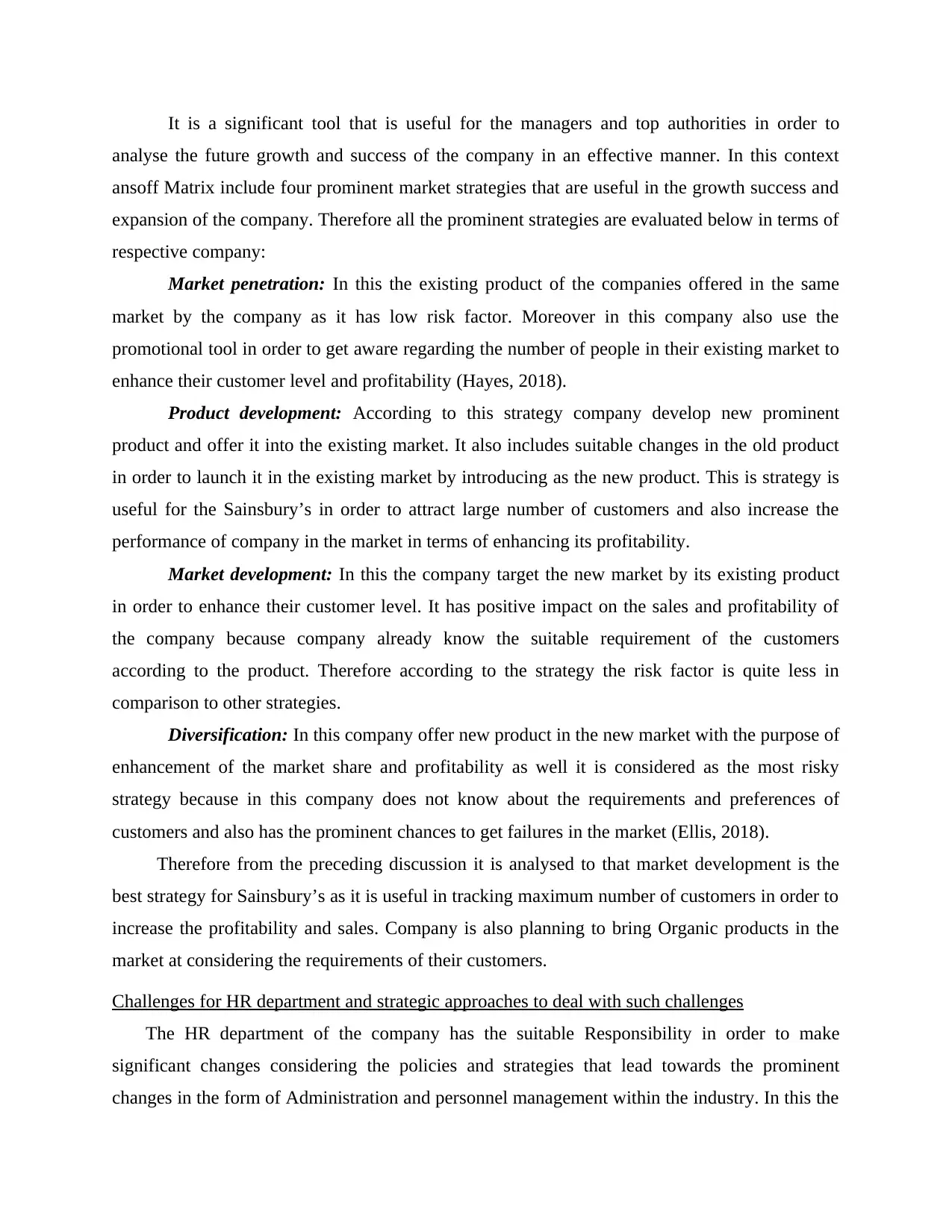
It is a significant tool that is useful for the managers and top authorities in order to
analyse the future growth and success of the company in an effective manner. In this context
ansoff Matrix include four prominent market strategies that are useful in the growth success and
expansion of the company. Therefore all the prominent strategies are evaluated below in terms of
respective company:
Market penetration: In this the existing product of the companies offered in the same
market by the company as it has low risk factor. Moreover in this company also use the
promotional tool in order to get aware regarding the number of people in their existing market to
enhance their customer level and profitability (Hayes, 2018).
Product development: According to this strategy company develop new prominent
product and offer it into the existing market. It also includes suitable changes in the old product
in order to launch it in the existing market by introducing as the new product. This is strategy is
useful for the Sainsbury’s in order to attract large number of customers and also increase the
performance of company in the market in terms of enhancing its profitability.
Market development: In this the company target the new market by its existing product
in order to enhance their customer level. It has positive impact on the sales and profitability of
the company because company already know the suitable requirement of the customers
according to the product. Therefore according to the strategy the risk factor is quite less in
comparison to other strategies.
Diversification: In this company offer new product in the new market with the purpose of
enhancement of the market share and profitability as well it is considered as the most risky
strategy because in this company does not know about the requirements and preferences of
customers and also has the prominent chances to get failures in the market (Ellis, 2018).
Therefore from the preceding discussion it is analysed to that market development is the
best strategy for Sainsbury’s as it is useful in tracking maximum number of customers in order to
increase the profitability and sales. Company is also planning to bring Organic products in the
market at considering the requirements of their customers.
Challenges for HR department and strategic approaches to deal with such challenges
The HR department of the company has the suitable Responsibility in order to make
significant changes considering the policies and strategies that lead towards the prominent
changes in the form of Administration and personnel management within the industry. In this the
analyse the future growth and success of the company in an effective manner. In this context
ansoff Matrix include four prominent market strategies that are useful in the growth success and
expansion of the company. Therefore all the prominent strategies are evaluated below in terms of
respective company:
Market penetration: In this the existing product of the companies offered in the same
market by the company as it has low risk factor. Moreover in this company also use the
promotional tool in order to get aware regarding the number of people in their existing market to
enhance their customer level and profitability (Hayes, 2018).
Product development: According to this strategy company develop new prominent
product and offer it into the existing market. It also includes suitable changes in the old product
in order to launch it in the existing market by introducing as the new product. This is strategy is
useful for the Sainsbury’s in order to attract large number of customers and also increase the
performance of company in the market in terms of enhancing its profitability.
Market development: In this the company target the new market by its existing product
in order to enhance their customer level. It has positive impact on the sales and profitability of
the company because company already know the suitable requirement of the customers
according to the product. Therefore according to the strategy the risk factor is quite less in
comparison to other strategies.
Diversification: In this company offer new product in the new market with the purpose of
enhancement of the market share and profitability as well it is considered as the most risky
strategy because in this company does not know about the requirements and preferences of
customers and also has the prominent chances to get failures in the market (Ellis, 2018).
Therefore from the preceding discussion it is analysed to that market development is the
best strategy for Sainsbury’s as it is useful in tracking maximum number of customers in order to
increase the profitability and sales. Company is also planning to bring Organic products in the
market at considering the requirements of their customers.
Challenges for HR department and strategic approaches to deal with such challenges
The HR department of the company has the suitable Responsibility in order to make
significant changes considering the policies and strategies that lead towards the prominent
changes in the form of Administration and personnel management within the industry. In this the
Paraphrase This Document
Need a fresh take? Get an instant paraphrase of this document with our AI Paraphraser
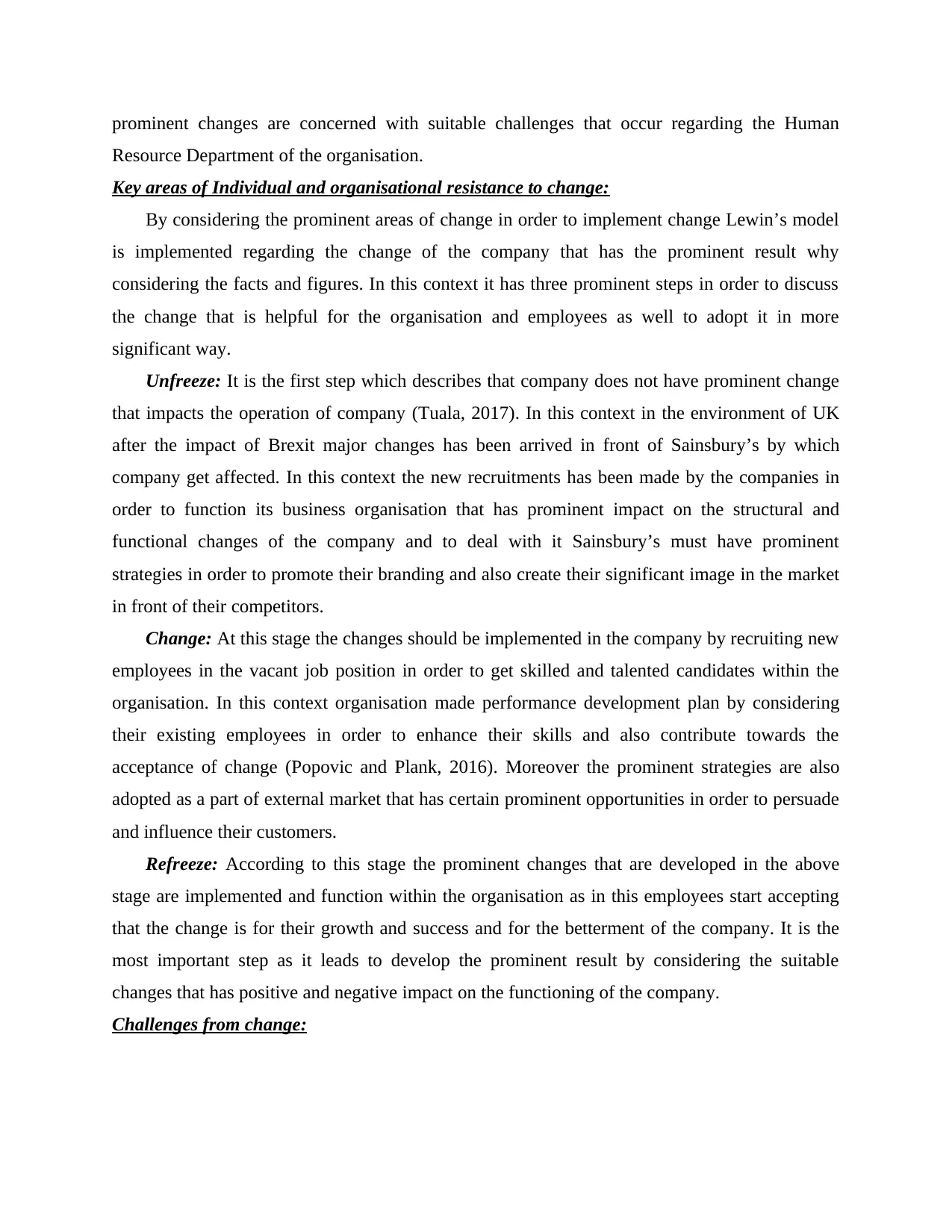
prominent changes are concerned with suitable challenges that occur regarding the Human
Resource Department of the organisation.
Key areas of Individual and organisational resistance to change:
By considering the prominent areas of change in order to implement change Lewin’s model
is implemented regarding the change of the company that has the prominent result why
considering the facts and figures. In this context it has three prominent steps in order to discuss
the change that is helpful for the organisation and employees as well to adopt it in more
significant way.
Unfreeze: It is the first step which describes that company does not have prominent change
that impacts the operation of company (Tuala, 2017). In this context in the environment of UK
after the impact of Brexit major changes has been arrived in front of Sainsbury’s by which
company get affected. In this context the new recruitments has been made by the companies in
order to function its business organisation that has prominent impact on the structural and
functional changes of the company and to deal with it Sainsbury’s must have prominent
strategies in order to promote their branding and also create their significant image in the market
in front of their competitors.
Change: At this stage the changes should be implemented in the company by recruiting new
employees in the vacant job position in order to get skilled and talented candidates within the
organisation. In this context organisation made performance development plan by considering
their existing employees in order to enhance their skills and also contribute towards the
acceptance of change (Popovic and Plank, 2016). Moreover the prominent strategies are also
adopted as a part of external market that has certain prominent opportunities in order to persuade
and influence their customers.
Refreeze: According to this stage the prominent changes that are developed in the above
stage are implemented and function within the organisation as in this employees start accepting
that the change is for their growth and success and for the betterment of the company. It is the
most important step as it leads to develop the prominent result by considering the suitable
changes that has positive and negative impact on the functioning of the company.
Challenges from change:
Resource Department of the organisation.
Key areas of Individual and organisational resistance to change:
By considering the prominent areas of change in order to implement change Lewin’s model
is implemented regarding the change of the company that has the prominent result why
considering the facts and figures. In this context it has three prominent steps in order to discuss
the change that is helpful for the organisation and employees as well to adopt it in more
significant way.
Unfreeze: It is the first step which describes that company does not have prominent change
that impacts the operation of company (Tuala, 2017). In this context in the environment of UK
after the impact of Brexit major changes has been arrived in front of Sainsbury’s by which
company get affected. In this context the new recruitments has been made by the companies in
order to function its business organisation that has prominent impact on the structural and
functional changes of the company and to deal with it Sainsbury’s must have prominent
strategies in order to promote their branding and also create their significant image in the market
in front of their competitors.
Change: At this stage the changes should be implemented in the company by recruiting new
employees in the vacant job position in order to get skilled and talented candidates within the
organisation. In this context organisation made performance development plan by considering
their existing employees in order to enhance their skills and also contribute towards the
acceptance of change (Popovic and Plank, 2016). Moreover the prominent strategies are also
adopted as a part of external market that has certain prominent opportunities in order to persuade
and influence their customers.
Refreeze: According to this stage the prominent changes that are developed in the above
stage are implemented and function within the organisation as in this employees start accepting
that the change is for their growth and success and for the betterment of the company. It is the
most important step as it leads to develop the prominent result by considering the suitable
changes that has positive and negative impact on the functioning of the company.
Challenges from change:
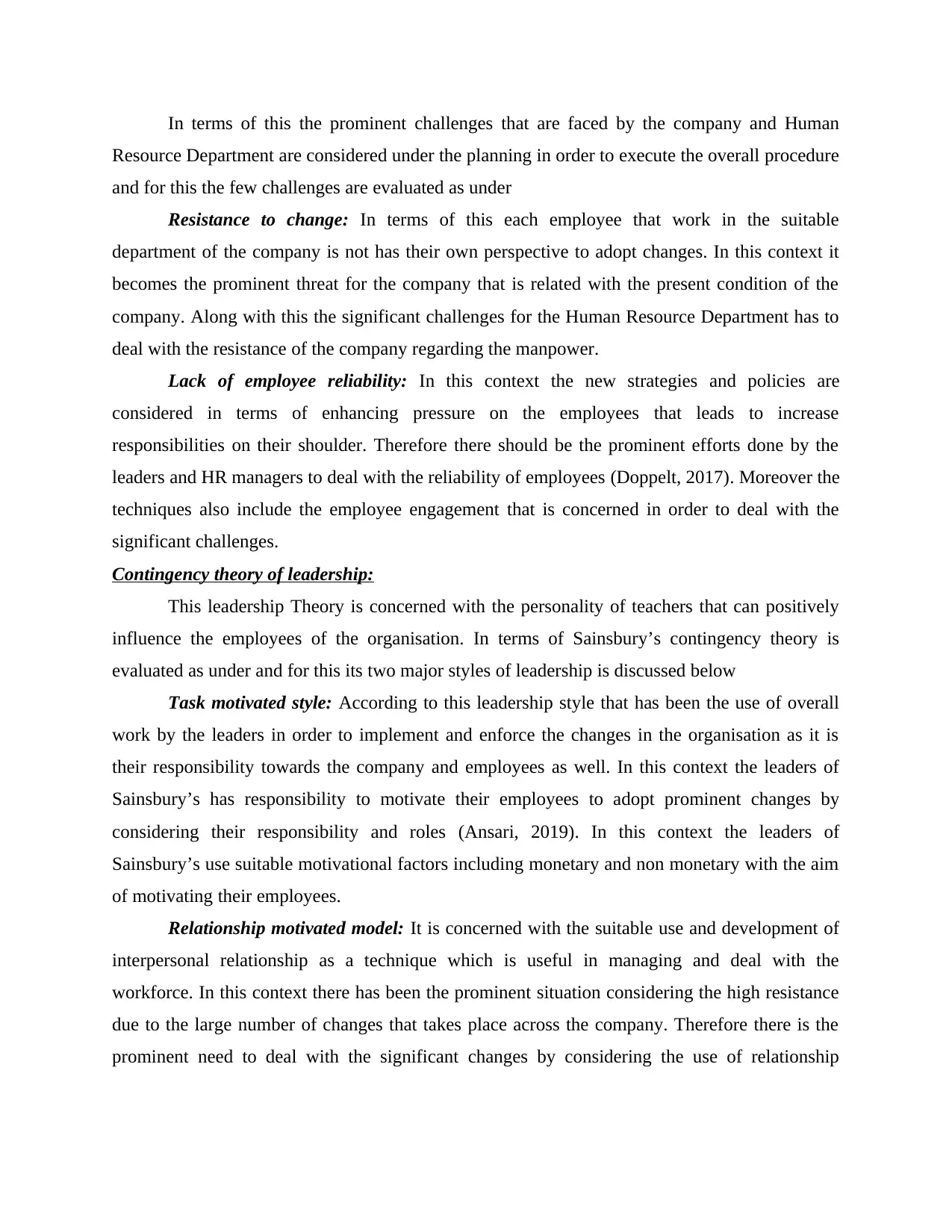
In terms of this the prominent challenges that are faced by the company and Human
Resource Department are considered under the planning in order to execute the overall procedure
and for this the few challenges are evaluated as under
Resistance to change: In terms of this each employee that work in the suitable
department of the company is not has their own perspective to adopt changes. In this context it
becomes the prominent threat for the company that is related with the present condition of the
company. Along with this the significant challenges for the Human Resource Department has to
deal with the resistance of the company regarding the manpower.
Lack of employee reliability: In this context the new strategies and policies are
considered in terms of enhancing pressure on the employees that leads to increase
responsibilities on their shoulder. Therefore there should be the prominent efforts done by the
leaders and HR managers to deal with the reliability of employees (Doppelt, 2017). Moreover the
techniques also include the employee engagement that is concerned in order to deal with the
significant challenges.
Contingency theory of leadership:
This leadership Theory is concerned with the personality of teachers that can positively
influence the employees of the organisation. In terms of Sainsbury’s contingency theory is
evaluated as under and for this its two major styles of leadership is discussed below
Task motivated style: According to this leadership style that has been the use of overall
work by the leaders in order to implement and enforce the changes in the organisation as it is
their responsibility towards the company and employees as well. In this context the leaders of
Sainsbury’s has responsibility to motivate their employees to adopt prominent changes by
considering their responsibility and roles (Ansari, 2019). In this context the leaders of
Sainsbury’s use suitable motivational factors including monetary and non monetary with the aim
of motivating their employees.
Relationship motivated model: It is concerned with the suitable use and development of
interpersonal relationship as a technique which is useful in managing and deal with the
workforce. In this context there has been the prominent situation considering the high resistance
due to the large number of changes that takes place across the company. Therefore there is the
prominent need to deal with the significant changes by considering the use of relationship
Resource Department are considered under the planning in order to execute the overall procedure
and for this the few challenges are evaluated as under
Resistance to change: In terms of this each employee that work in the suitable
department of the company is not has their own perspective to adopt changes. In this context it
becomes the prominent threat for the company that is related with the present condition of the
company. Along with this the significant challenges for the Human Resource Department has to
deal with the resistance of the company regarding the manpower.
Lack of employee reliability: In this context the new strategies and policies are
considered in terms of enhancing pressure on the employees that leads to increase
responsibilities on their shoulder. Therefore there should be the prominent efforts done by the
leaders and HR managers to deal with the reliability of employees (Doppelt, 2017). Moreover the
techniques also include the employee engagement that is concerned in order to deal with the
significant challenges.
Contingency theory of leadership:
This leadership Theory is concerned with the personality of teachers that can positively
influence the employees of the organisation. In terms of Sainsbury’s contingency theory is
evaluated as under and for this its two major styles of leadership is discussed below
Task motivated style: According to this leadership style that has been the use of overall
work by the leaders in order to implement and enforce the changes in the organisation as it is
their responsibility towards the company and employees as well. In this context the leaders of
Sainsbury’s has responsibility to motivate their employees to adopt prominent changes by
considering their responsibility and roles (Ansari, 2019). In this context the leaders of
Sainsbury’s use suitable motivational factors including monetary and non monetary with the aim
of motivating their employees.
Relationship motivated model: It is concerned with the suitable use and development of
interpersonal relationship as a technique which is useful in managing and deal with the
workforce. In this context there has been the prominent situation considering the high resistance
due to the large number of changes that takes place across the company. Therefore there is the
prominent need to deal with the significant changes by considering the use of relationship
⊘ This is a preview!⊘
Do you want full access?
Subscribe today to unlock all pages.

Trusted by 1+ million students worldwide
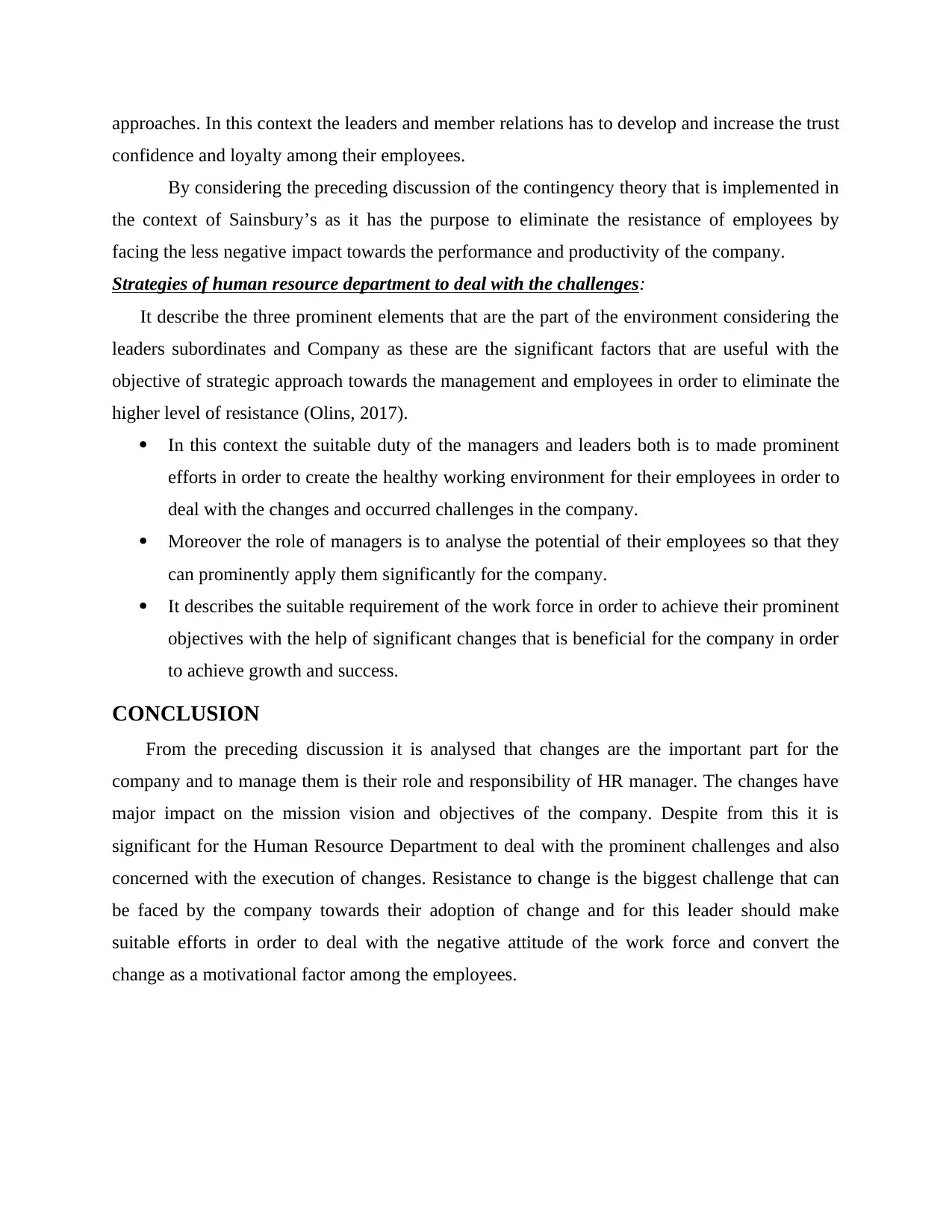
approaches. In this context the leaders and member relations has to develop and increase the trust
confidence and loyalty among their employees.
By considering the preceding discussion of the contingency theory that is implemented in
the context of Sainsbury’s as it has the purpose to eliminate the resistance of employees by
facing the less negative impact towards the performance and productivity of the company.
Strategies of human resource department to deal with the challenges:
It describe the three prominent elements that are the part of the environment considering the
leaders subordinates and Company as these are the significant factors that are useful with the
objective of strategic approach towards the management and employees in order to eliminate the
higher level of resistance (Olins, 2017).
In this context the suitable duty of the managers and leaders both is to made prominent
efforts in order to create the healthy working environment for their employees in order to
deal with the changes and occurred challenges in the company.
Moreover the role of managers is to analyse the potential of their employees so that they
can prominently apply them significantly for the company.
It describes the suitable requirement of the work force in order to achieve their prominent
objectives with the help of significant changes that is beneficial for the company in order
to achieve growth and success.
CONCLUSION
From the preceding discussion it is analysed that changes are the important part for the
company and to manage them is their role and responsibility of HR manager. The changes have
major impact on the mission vision and objectives of the company. Despite from this it is
significant for the Human Resource Department to deal with the prominent challenges and also
concerned with the execution of changes. Resistance to change is the biggest challenge that can
be faced by the company towards their adoption of change and for this leader should make
suitable efforts in order to deal with the negative attitude of the work force and convert the
change as a motivational factor among the employees.
confidence and loyalty among their employees.
By considering the preceding discussion of the contingency theory that is implemented in
the context of Sainsbury’s as it has the purpose to eliminate the resistance of employees by
facing the less negative impact towards the performance and productivity of the company.
Strategies of human resource department to deal with the challenges:
It describe the three prominent elements that are the part of the environment considering the
leaders subordinates and Company as these are the significant factors that are useful with the
objective of strategic approach towards the management and employees in order to eliminate the
higher level of resistance (Olins, 2017).
In this context the suitable duty of the managers and leaders both is to made prominent
efforts in order to create the healthy working environment for their employees in order to
deal with the changes and occurred challenges in the company.
Moreover the role of managers is to analyse the potential of their employees so that they
can prominently apply them significantly for the company.
It describes the suitable requirement of the work force in order to achieve their prominent
objectives with the help of significant changes that is beneficial for the company in order
to achieve growth and success.
CONCLUSION
From the preceding discussion it is analysed that changes are the important part for the
company and to manage them is their role and responsibility of HR manager. The changes have
major impact on the mission vision and objectives of the company. Despite from this it is
significant for the Human Resource Department to deal with the prominent challenges and also
concerned with the execution of changes. Resistance to change is the biggest challenge that can
be faced by the company towards their adoption of change and for this leader should make
suitable efforts in order to deal with the negative attitude of the work force and convert the
change as a motivational factor among the employees.
Paraphrase This Document
Need a fresh take? Get an instant paraphrase of this document with our AI Paraphraser
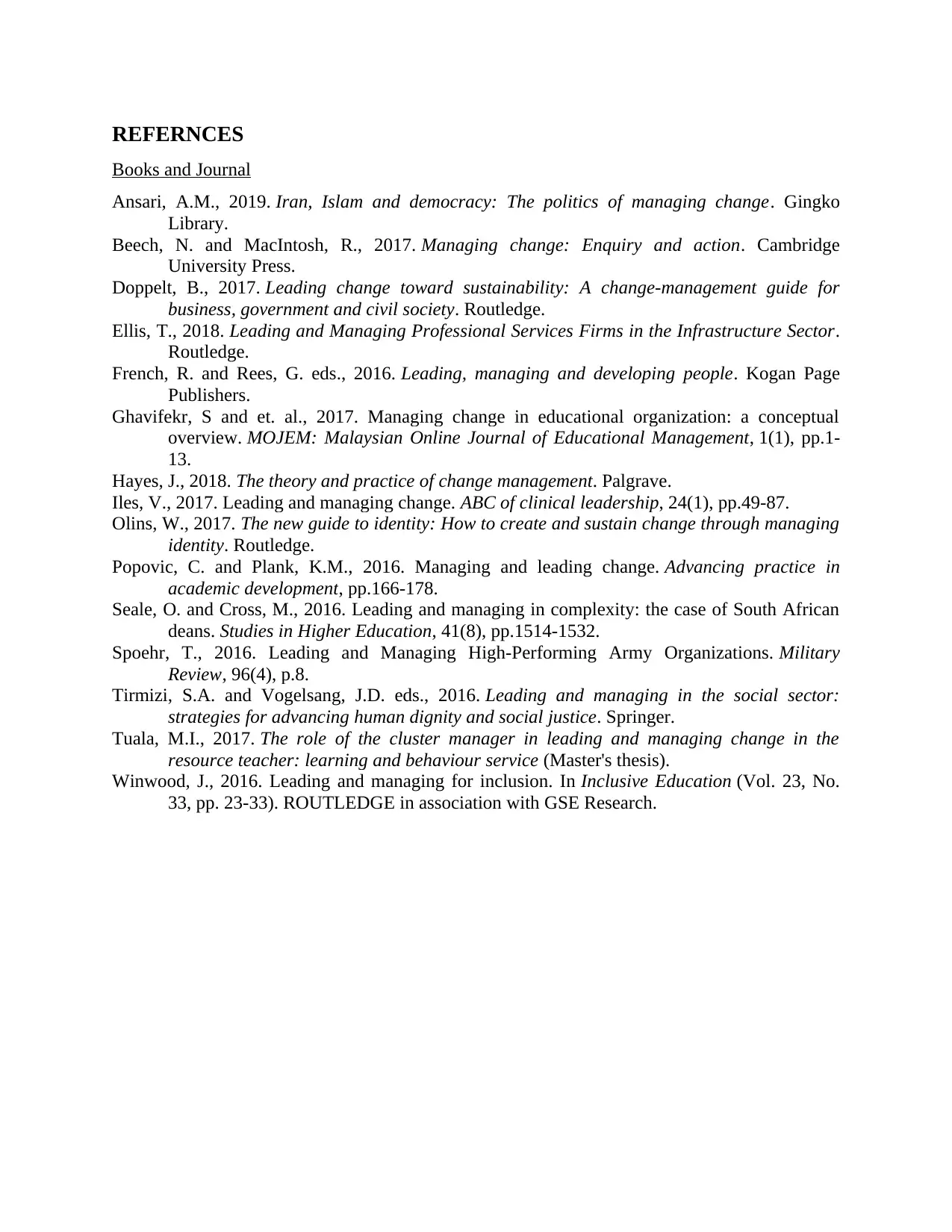
REFERNCES
Books and Journal
Ansari, A.M., 2019. Iran, Islam and democracy: The politics of managing change. Gingko
Library.
Beech, N. and MacIntosh, R., 2017. Managing change: Enquiry and action. Cambridge
University Press.
Doppelt, B., 2017. Leading change toward sustainability: A change-management guide for
business, government and civil society. Routledge.
Ellis, T., 2018. Leading and Managing Professional Services Firms in the Infrastructure Sector.
Routledge.
French, R. and Rees, G. eds., 2016. Leading, managing and developing people. Kogan Page
Publishers.
Ghavifekr, S and et. al., 2017. Managing change in educational organization: a conceptual
overview. MOJEM: Malaysian Online Journal of Educational Management, 1(1), pp.1-
13.
Hayes, J., 2018. The theory and practice of change management. Palgrave.
Iles, V., 2017. Leading and managing change. ABC of clinical leadership, 24(1), pp.49-87.
Olins, W., 2017. The new guide to identity: How to create and sustain change through managing
identity. Routledge.
Popovic, C. and Plank, K.M., 2016. Managing and leading change. Advancing practice in
academic development, pp.166-178.
Seale, O. and Cross, M., 2016. Leading and managing in complexity: the case of South African
deans. Studies in Higher Education, 41(8), pp.1514-1532.
Spoehr, T., 2016. Leading and Managing High-Performing Army Organizations. Military
Review, 96(4), p.8.
Tirmizi, S.A. and Vogelsang, J.D. eds., 2016. Leading and managing in the social sector:
strategies for advancing human dignity and social justice. Springer.
Tuala, M.I., 2017. The role of the cluster manager in leading and managing change in the
resource teacher: learning and behaviour service (Master's thesis).
Winwood, J., 2016. Leading and managing for inclusion. In Inclusive Education (Vol. 23, No.
33, pp. 23-33). ROUTLEDGE in association with GSE Research.
Books and Journal
Ansari, A.M., 2019. Iran, Islam and democracy: The politics of managing change. Gingko
Library.
Beech, N. and MacIntosh, R., 2017. Managing change: Enquiry and action. Cambridge
University Press.
Doppelt, B., 2017. Leading change toward sustainability: A change-management guide for
business, government and civil society. Routledge.
Ellis, T., 2018. Leading and Managing Professional Services Firms in the Infrastructure Sector.
Routledge.
French, R. and Rees, G. eds., 2016. Leading, managing and developing people. Kogan Page
Publishers.
Ghavifekr, S and et. al., 2017. Managing change in educational organization: a conceptual
overview. MOJEM: Malaysian Online Journal of Educational Management, 1(1), pp.1-
13.
Hayes, J., 2018. The theory and practice of change management. Palgrave.
Iles, V., 2017. Leading and managing change. ABC of clinical leadership, 24(1), pp.49-87.
Olins, W., 2017. The new guide to identity: How to create and sustain change through managing
identity. Routledge.
Popovic, C. and Plank, K.M., 2016. Managing and leading change. Advancing practice in
academic development, pp.166-178.
Seale, O. and Cross, M., 2016. Leading and managing in complexity: the case of South African
deans. Studies in Higher Education, 41(8), pp.1514-1532.
Spoehr, T., 2016. Leading and Managing High-Performing Army Organizations. Military
Review, 96(4), p.8.
Tirmizi, S.A. and Vogelsang, J.D. eds., 2016. Leading and managing in the social sector:
strategies for advancing human dignity and social justice. Springer.
Tuala, M.I., 2017. The role of the cluster manager in leading and managing change in the
resource teacher: learning and behaviour service (Master's thesis).
Winwood, J., 2016. Leading and managing for inclusion. In Inclusive Education (Vol. 23, No.
33, pp. 23-33). ROUTLEDGE in association with GSE Research.
1 out of 11
Related Documents
Your All-in-One AI-Powered Toolkit for Academic Success.
+13062052269
info@desklib.com
Available 24*7 on WhatsApp / Email
![[object Object]](/_next/static/media/star-bottom.7253800d.svg)
Unlock your academic potential
Copyright © 2020–2025 A2Z Services. All Rights Reserved. Developed and managed by ZUCOL.




